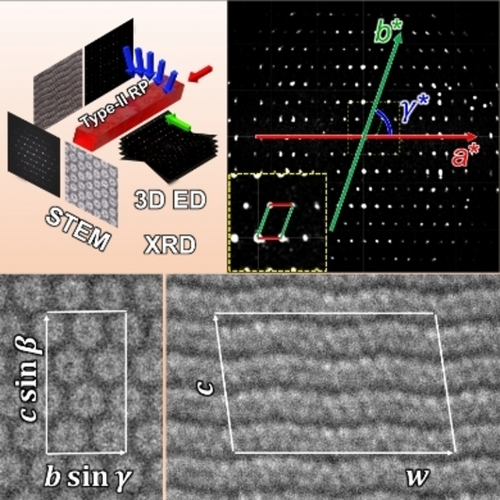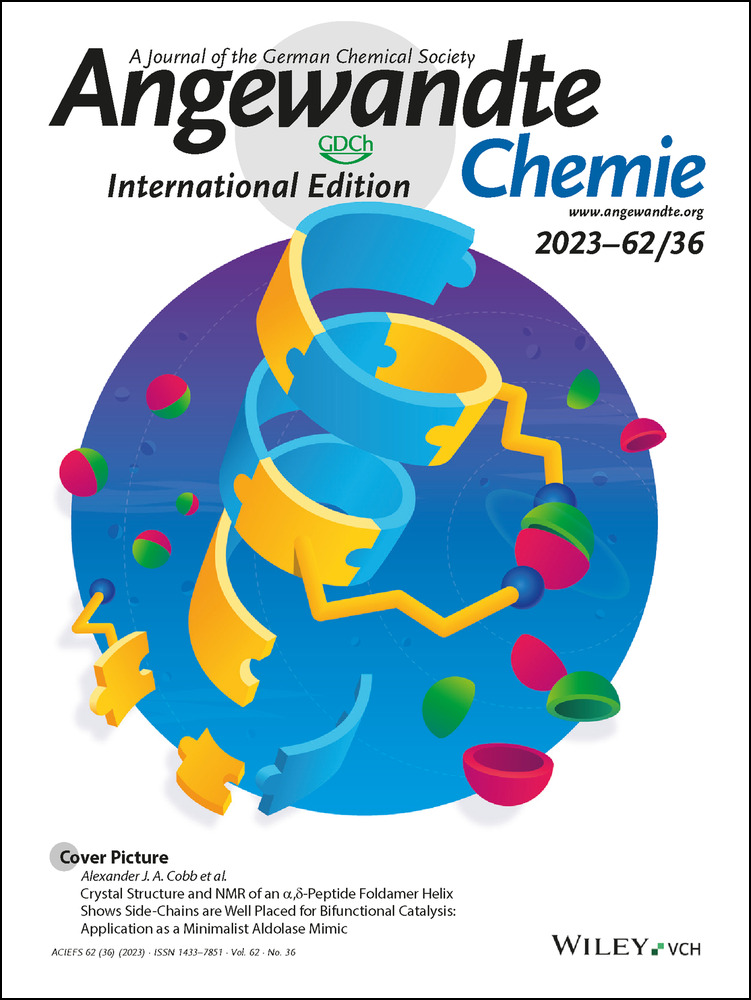Type-II Red Phosphorus: Wavy Packing of Twisted Pentagonal Tubes
Jun-Yeong Yoon
Department of Physics, Yonsei University, Seoul, 03722 Korea
Center for Nanomedicine, Institute for Basic Science (IBS), Seoul, 03722 Korea
Search for more papers by this authorYangjin Lee
Department of Physics, Yonsei University, Seoul, 03722 Korea
Center for Nanomedicine, Institute for Basic Science (IBS), Seoul, 03722 Korea
Search for more papers by this authorDong-Gyu Kim
Department of Physics, Yonsei University, Seoul, 03722 Korea
Search for more papers by this authorDong Gun Oh
Department of Physics, Yonsei University, Seoul, 03722 Korea
Search for more papers by this authorJin Kyun Kim
Department of Physics, Ulsan National Institute of Science and Technology (UNIST), Ulsan, 44919 Korea
Present address: Division of Industrial Metrology, Korea Research Institute of Standards and Science, Daejeon, 34113 Korea
Search for more papers by this authorLinshuo Guo
School of Physical Science and Technology &, Shanghai Key Laboratory of High-resolution Electron Microscopy, ShanghaiTech University, Shanghai, 201210 China
Search for more papers by this authorJungcheol Kim
Department of Physics, Sogang University, Seoul, 04107 Korea
Search for more papers by this authorJeongheon Choe
Department of Physics, Yonsei University, Seoul, 03722 Korea
Search for more papers by this authorKihyun Lee
Department of Physics, Yonsei University, Seoul, 03722 Korea
Center for Nanomedicine, Institute for Basic Science (IBS), Seoul, 03722 Korea
Search for more papers by this authorHyeonsik Cheong
Department of Physics, Sogang University, Seoul, 04107 Korea
Search for more papers by this authorChae Un Kim
Department of Physics, Ulsan National Institute of Science and Technology (UNIST), Ulsan, 44919 Korea
Search for more papers by this authorYoung Jai Choi
Department of Physics, Yonsei University, Seoul, 03722 Korea
Search for more papers by this authorCorresponding Author
Yanhang Ma
School of Physical Science and Technology &, Shanghai Key Laboratory of High-resolution Electron Microscopy, ShanghaiTech University, Shanghai, 201210 China
Search for more papers by this authorCorresponding Author
Kwanpyo Kim
Department of Physics, Yonsei University, Seoul, 03722 Korea
Center for Nanomedicine, Institute for Basic Science (IBS), Seoul, 03722 Korea
Search for more papers by this authorJun-Yeong Yoon
Department of Physics, Yonsei University, Seoul, 03722 Korea
Center for Nanomedicine, Institute for Basic Science (IBS), Seoul, 03722 Korea
Search for more papers by this authorYangjin Lee
Department of Physics, Yonsei University, Seoul, 03722 Korea
Center for Nanomedicine, Institute for Basic Science (IBS), Seoul, 03722 Korea
Search for more papers by this authorDong-Gyu Kim
Department of Physics, Yonsei University, Seoul, 03722 Korea
Search for more papers by this authorDong Gun Oh
Department of Physics, Yonsei University, Seoul, 03722 Korea
Search for more papers by this authorJin Kyun Kim
Department of Physics, Ulsan National Institute of Science and Technology (UNIST), Ulsan, 44919 Korea
Present address: Division of Industrial Metrology, Korea Research Institute of Standards and Science, Daejeon, 34113 Korea
Search for more papers by this authorLinshuo Guo
School of Physical Science and Technology &, Shanghai Key Laboratory of High-resolution Electron Microscopy, ShanghaiTech University, Shanghai, 201210 China
Search for more papers by this authorJungcheol Kim
Department of Physics, Sogang University, Seoul, 04107 Korea
Search for more papers by this authorJeongheon Choe
Department of Physics, Yonsei University, Seoul, 03722 Korea
Search for more papers by this authorKihyun Lee
Department of Physics, Yonsei University, Seoul, 03722 Korea
Center for Nanomedicine, Institute for Basic Science (IBS), Seoul, 03722 Korea
Search for more papers by this authorHyeonsik Cheong
Department of Physics, Sogang University, Seoul, 04107 Korea
Search for more papers by this authorChae Un Kim
Department of Physics, Ulsan National Institute of Science and Technology (UNIST), Ulsan, 44919 Korea
Search for more papers by this authorYoung Jai Choi
Department of Physics, Yonsei University, Seoul, 03722 Korea
Search for more papers by this authorCorresponding Author
Yanhang Ma
School of Physical Science and Technology &, Shanghai Key Laboratory of High-resolution Electron Microscopy, ShanghaiTech University, Shanghai, 201210 China
Search for more papers by this authorCorresponding Author
Kwanpyo Kim
Department of Physics, Yonsei University, Seoul, 03722 Korea
Center for Nanomedicine, Institute for Basic Science (IBS), Seoul, 03722 Korea
Search for more papers by this authorGraphical Abstract
The crystal structure of type-II red phosphorus is investigated by various structural characterizations, including 3D electron diffraction, atomic-resolution STEM imaging, and powder X-ray diffraction. A triclinic unit cell with a large volume containing around 250 phosphorus atoms is identified via 3D electron diffraction. The twisted wavy tubular motif, a new variation of building blocks in phosphorus, is also revealed via STEM.
Abstract
Elemental phosphorus exhibits fascinating structural varieties and versatile properties. The unique nature of phosphorus bonds can lead to the formation of extremely complex structures, and detailed structural information on some phosphorus polymorphs is yet to be investigated. In this study, we investigated an unidentified crystalline phase of phosphorus, type-II red phosphorus (RP), by combining state-of-the-art structural characterization techniques. Electron diffraction tomography, atomic-resolution scanning transmission electron microscopy (STEM), powder X-ray diffraction, and Raman spectroscopy were concurrently used to elucidate the hidden structural motifs and their packing in type-II RP. Electron diffraction tomography, performed using individual crystalline nanowires, was used to identify a triclinic unit cell with volume of 5330 Å3, which is the largest unit cell for elemental phosphorus crystals up to now and contains approximately 250 phosphorus atoms. Atomic-resolution STEM imaging, which was performed along different crystal-zone axes, confirmed that the twisted wavy tubular motif is the basic building block of type-II RP. Our study discovered and presented a new variation of building blocks in phosphorus, and it provides insights to clarify the complexities observed in phosphorus as well as other relevant systems.
Conflict of interest
The authors declare no conflict of interest.
Open Research
Data Availability Statement
The data that support the findings of this study are available from the corresponding author upon reasonable request.
Supporting Information
As a service to our authors and readers, this journal provides supporting information supplied by the authors. Such materials are peer reviewed and may be re-organized for online delivery, but are not copy-edited or typeset. Technical support issues arising from supporting information (other than missing files) should be addressed to the authors.
| Filename | Description |
|---|---|
| anie202307102-sup-0001-misc_information.pdf2.4 MB | Supporting Information |
Please note: The publisher is not responsible for the content or functionality of any supporting information supplied by the authors. Any queries (other than missing content) should be directed to the corresponding author for the article.
References
- 1D. E. Corbridge, Phosphorus: chemistry, biochemistry and technology, CRC press, Boca Raton, 2013.
- 2W. L. Roth, T. W. DeWitt, A. J. Smith, J. Am. Chem. Soc. 1947, 69, 2881–2885.
- 3M. Haeser, J. Am. Chem. Soc. 1994, 116, 6925–6926.
- 4A. J. Karttunen, M. Linnolahti, T. A. Pakkanen, ChemPhysChem 2008, 9, 2550–2558.
- 5J. M. Zaug, A. K. Soper, S. M. Clark, Nat. Mater. 2008, 7, 890–899.
- 6F. Bachhuber, J. von Appen, R. Dronskowski, P. Schmidt, T. Nilges, A. Pfitzner, R. Weihrich, Angew. Chem. Int. Ed. 2014, 53, 11629–11633.
- 7Y. Zhou, W. Kirkpatrick, V. L. Deringer, Adv. Mater. 2022, 34, 2107515.
- 8S. Böcker, M. Häser, Z. Anorg. Allg. Chem. 1995, 621, 258–286.
- 9J. Zhang, D. Zhao, D. Xiao, C. Ma, H. Du, X. Li, L. Zhang, J. Huang, H. Huang, C.-L. Jia, D. Tománek, C. Niu, Angew. Chem. Int. Ed. 2017, 56, 1850–1854.
- 10M. Hart, E. R. White, J. Chen, C. M. Mcgilvery, C. J. Pickard, A. Michaelides, A. Sella, M. S. P. Shaffer, C. G. Salzmann, Angew. Chem. Int. Ed. 2017, 56, 8144–8148.
- 11G. Sansone, L. Maschio, A. J. Karttunen, Chem. Eur. J. 2017, 23, 15884–15888.
- 12V. L. Deringer, C. J. Pickard, D. M. Proserpio, Angew. Chem. Int. Ed. 2020, 59, 15880–15885.
- 13Z. Zhu, D. Tománek, Phys. Rev. Lett. 2014, 112, 176802.
- 14D. V. Rybkovskiy, V. O. Koroteev, A. Impellizzeri, A. A. Vorfolomeeva, E. Y. Gerasimov, A. V. Okotrub, A. Chuvilin, L. G. Bulusheva, C. P. Ewels, ACS Nano 2022, 16, 6002–6012.
- 15L. Zhang, H. Huang, B. Zhang, M. Gu, D. Zhao, X. Zhao, L. Li, J. Zhou, K. Wu, Y. Cheng, J. Zhang, Angew. Chem. Int. Ed. 2020, 59, 1074–1080.
- 16G. Cicirello, M. Wang, Q. P. Sam, J. L. Hart, N. L. Williams, H. Yin, J. J. Cha, J. Wang, J. Am. Chem. Soc. 2023, 145, 8218–8230.
- 17A. Pfitzner, M. F. Bräu, J. Zweck, G. Brunklaus, H. Eckert, Angew. Chem. Int. Ed. 2004, 43, 4228–4231.
- 18L. Li, Y. Yu, G. J. Ye, Q. Ge, X. Ou, H. Wu, D. Feng, X. H. Chen, Y. Zhang, Nat. Nanotechnol. 2014, 9, 372–377.
- 19G. Schusteritsch, M. Uhrin, C. J. Pickard, Nano Lett. 2016, 16, 2975–2980.
- 20Z. Yang, J. Hao, S. Yuan, S. Lin, H. M. Yau, J. Dai, S. P. Lau, Adv. Mater. 2015, 27, 3748–3754.
- 21P. E. M. Amaral, G. P. Nieman, G. R. Schwenk, H. Jing, R. Zhang, E. B. Cerkez, D. Strongin, H. F. Ji, Angew. Chem. Int. Ed. 2019, 58, 6766–6771.
- 22L. Du, Y. Zhao, L. Wu, X. Hu, L. Yao, Y. Wang, X. Bai, Y. Dai, J. Qiao, M. G. Uddin, X. Li, J. Lahtinen, X. Bai, G. Zhang, W. Ji, Z. Sun, Nat. Commun. 2021, 12, 4822.
- 23H. Thurn, H. Kerbs, Angew. Chem. Int. Ed. 1966, 5, 1047–1048.
- 24A. G. Ricciardulli, Y. Wang, S. Yang, P. Samorì, J. Am. Chem. Soc. 2022, 144, 3660–3666.
- 25M. Ruck, D. Hoppe, B. Wahl, P. Simon, Y. Wang, G. Seifert, Angew. Chem. Int. Ed. 2005, 44, 7616–7619.
- 26R. A. L. Winchester, M. Whitby, M. S. P. Shaffer, Angew. Chem. Int. Ed. 2009, 48, 3616–3621.
- 27Z. Shen, Z. Hu, W. Wang, S.-F. Lee, D. K. L. Chan, Y. Li, T. Gu, J. C. Yu, Nanoscale 2014, 6, 14163–14167.
- 28J. B. Smith, D. Hagaman, D. Diguiseppi, R. Schweitzer-Stenner, H.-F. Ji, Angew. Chem. Int. Ed. 2016, 55, 11829–11833.
- 29Q. Liu, X. Zhang, J. Wang, Y. Zhang, S. Bian, Z. Cheng, N. Kang, H. Huang, S. Gu, Y. Wang, D. Liu, P. K. Chu, X. F. Yu, Angew. Chem. Int. Ed. 2020, 59, 14383–14387.
- 30Y. Zhu, J. Ren, X. Zhang, D. Yang, Nanoscale 2020, 12, 13297–13310.
- 31S. Lange, P. Schmidt, T. Nilges, Inorg. Chem. 2007, 46, 4028–4035.
- 32L. Zhang, M. Gu, L. Li, X. Zhao, C. Fu, T. Liu, X. Xu, Y. Cheng, J. Zhang, Chem. Mater. 2020, 32, 7363–7369.
- 33M. R. P. Pielmeier, T. Nilges, Angew. Chem. Int. Ed. 2021, 60, 6816–6823.
- 34L. Zhang, H. Huang, Z. Lv, L. Li, M. Gu, X. Zhao, B. Zhang, Y. Cheng, J. Zhang, ACS Appl. Electron. Mater. 2021, 3, 1043–1049.
- 35J. Li, J. Sun, Acc. Chem. Res. 2017, 50, 2737–2745.
- 36L. Meshi, S. Samuha, Adv. Mater. 2018, 30, 1706704.
- 37P. Brázda, L. Palatinus, M. Babor, Science 2019, 364, 667–669.
- 38A. Favron, E. Gaufrès, F. Fossard, A.-L. Phaneuf-L'Heureux, N. Y.-W. Tang, P. L. Lévesque, A. Loiseau, R. Leonelli, S. Francoeur, R. Martel, Nat. Mater. 2015, 14, 826–832.





